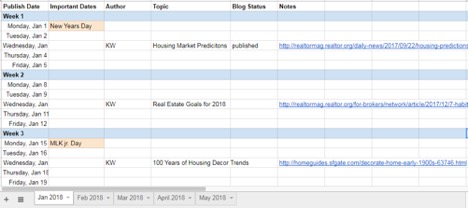
This step-by-step guide will show brokers how to create an editorial calendar for their real estate website to keep a blog active for the long haul.
According to the Real Estate in a Digital Age 2017 Report by the National Association of REALTORS®, more than 90 percent of real estate firms have websites. So, how are you going to make yours stand out?
One of the best ways to drive traffic to your site is to publish regular, updated content. Digital marketing content ideas include original blog posts, articles, infographics, research, podcasts, videos, pictures, ebooks, newsletters, and any other written, graphical, or interactive piece of media. This will provide value to your website and build your authority as a business owner.
Actively posting to your blog shows your clients that you value the time they spend online and that you are involved in the industry beyond the homebuying and homeselling process. Creating sharable pieces of content that are of interest to others increases your chances of being discovered online exponentially.
But one of the biggest challenges of maintaining a real estate blog is sticking to a schedule and routinely posting. Nothing is worse than a blog in a dead zone, with the last post showing a date from years ago. If you haven’t posted anything in a while, or are struggling to stick to a writing schedule, you need to create an editorial calendar.
An editorial calendar is simply a schedule for posting to your company website or blog. It can be laid out in a calendar, planner, or spreadsheet. It’s the most useful tool I have when it comes to actively posting articles to my website and growing our traffic. I’ve been writing about real estate for more than three years—sometimes producing more than five articles a week—and I wouldn’t be able to do it without an editorial calendar. Here is a five-step guide to help you get started.
1. Decide how often you are going to post.
If I go to a company website and see a blog that hasn’t been updated in a long time, I immediately assume they aren’t maintaining their website and am leery of how they will handle my business. The key to a good blog is quality and consistency. If you believe you will only be able to post once a week or even once a month, that’s OK. But you have to follow through.
2. Create an editorial calendar spreadsheet.
I am a big fan of Google Sheets, thanks to the shareability and ease of access across devices, but Excel works well too. You can create a blog posting schedule for the month, where you can list the author, topic, status of the article (started, draft complete, published), and any notes. I like to use the notes section to include ideas or links to other articles I can reference. I also like to make a note of any important dates like holidays that could be the inspiration for an article, such as Halloween safety in October.
Here’s an example from my editorial calendar spreadsheet. You can see I choose to post once a week on Wednesdays.

I suggest creating a new sheet for each month. At the start of each week, you can open your editorial calendar and see what article you are going to write and publish on your blog that week.
3. Consider seasonal themes and trends.
Creating a calendar allows you to consider the entire year as you brainstorm article topic ideas. For example, each season offers the opportunity to discuss seasonal maintenance. The beginning of the year is a good time to talk about new year goals and tax tips. May is considered national moving month, so an article that offers moving tips is timely.
Real estate historically has prominent trends throughout the year as well, on which you can provide commentary. Months that are traditionally slow or busy can give you an opportunity to give tips (such as selling in the off season); statistics and reports that come out on a quarterly basis from industry associations that you can repurpose (for example, here’s how these national trends are affecting us locally); and monitoring news in the media that pertain to real estate throughout the year (which could be new laws and regulations).
If you consider seasonal themes and industry trends, it’s easy to think of at least one timely article per month.
4. Write down your article ideas.
As a real estate professional, you have a plethora of options to write about your for housing blog. Essentially, anything related to the housing industry can provide value to your clients and establish your company as industry experts.
You can start a list of article ideas on a new sheet in your editorial calendar. Remember that your future clients will come to your website for information about the local area, homebuying and homeselling tips, and general news about the state of the housing market. You can also have a whole section about maintenance and decor tips.
Here are some ideas:
- Seasonal maintenance for homeowners
- Renovations that add value to a home
- Housing news
- Housing trends
- Best-of series for your area: best coffee shops, restaurants, salons, parks, hikes, and other highlights
- Home staging tips
- How to pick a real estate agent
5. Fill out your calendar.
Staring at a blank screen trying to decide what to write can be a challenge. But now you’ve done some brainstorming, take your list of topic ideas and simply copy and paste them into your editorial calendar. If you spend a little bit of time up front with some careful planning, starting a blog for your website doesn’t feel like such an overwhelming task. Even short articles will help to boost your traffic and reputation, letting your audience know that you are engaged with and an expert in your field.











Comments